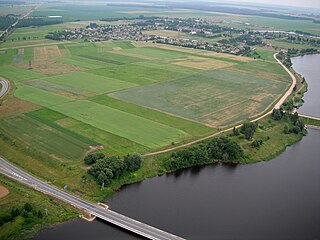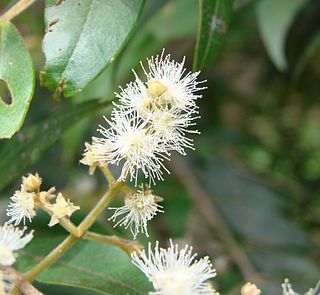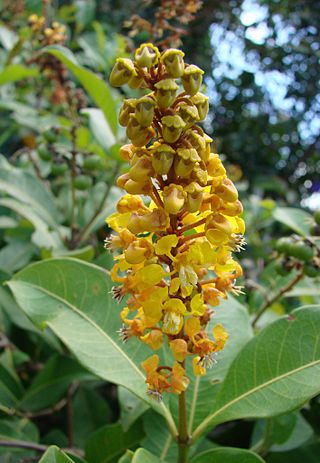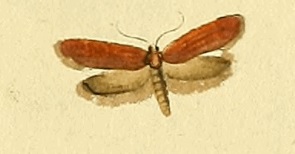
Histidine (symbol His or H) is an essential amino acid that is used in the biosynthesis of proteins. It contains an α-amino group (which is in the protonated –NH3+ form under biological conditions), a carboxylic acid group (which is in the deprotonated –COO− form under biological conditions), and an imidazole side chain (which is partially protonated), classifying it as a positively charged amino acid at physiological pH. Initially thought essential only for infants, it has now been shown in longer-term studies to be essential for adults also. It is encoded by the codons CAU and CAC.

Neurospora crassa is a type of red bread mold of the phylum Ascomycota. The genus name, meaning 'nerve spore' in Greek, refers to the characteristic striations on the spores. The first published account of this fungus was from an infestation of French bakeries in 1843.

Cycloheximide is a naturally occurring fungicide produced by the bacterium Streptomyces griseus. Cycloheximide exerts its effects by interfering with the translocation step in protein synthesis, thus blocking eukaryotic translational elongation. Cycloheximide is widely used in biomedical research to inhibit protein synthesis in eukaryotic cells studied in vitro. It is inexpensive and works rapidly. Its effects are rapidly reversed by simply removing it from the culture medium.

Kėdainiai District Municipality is one of 60 municipalities in Lithuania, located in the central part of the country.

Neurospora is a genus of Ascomycete fungi. The genus name, meaning "nerve spore" refers to the characteristic striations on the spores that resemble axons.

Myrcia is a genus of plants in the family Myrtaceae, containing about 765 species as of 2022. They are distributed in Central and South America, Mexico, and the Caribbean, with centers of diversity in the Brazilian Cerrado and Atlantic Forests ecoregions. Myrcia was first described as a genus in 1827.

The FIAPF, created in 1933, is an organization composed with 36 member associations from 30 of the leading audiovisual production countries. Its Secretariat is located in Brussels, Belgium. FIAPF is also in charge of regulating international film festivals, including some of the world's most important ones.

Byrsonima is one of about 75 genera in the Malpighiaceae, a family of flowering plants in the order Malpighiales. In particular in American English, they are known as locustberries. Another widely seen common name is serrets or serrettes.

The Intercontinental Rally Challenge was an FIA-sanctioned rallying series organised by SRW Events and Eurosport Events, and aimed to "give new opportunities to young or amateur rally drivers competing in recognised regional and international rallies, while offering organisers an innovative TV format concept, created by Eurosport." The series focused on Group N and Group A spec cars up to 2000 cc, including Super 2000, R4, R2 and R3.

The Tasman Island, part of the Tasman Island Group, is an oval island with an area of 1.2 square kilometres (0.46 sq mi), lying close to the south-eastern coast of Tasmania, Australia. The island is located in the Tasman Sea, situated off the Tasman Peninsula and is contained within the Tasman National Park.

Bellamya is a genus of freshwater snails with a gill and an operculum, aquatic gastropod mollusks in the family Viviparidae.
Lindra is a genus of fungi within the Lulworthiaceae family.

Crassa is a genus of the concealer moth family (Oecophoridae). Among these, it belongs to subfamily Oecophorinae. The genus name Tichonia, established by J. Hübner in 1825, was frequently misapplied to these moths by earlier authors. But as the type species of Hübner's genus is the greenweed flat-body moth – originally described as Tinea atomella, but nowadays called Agonopterix atomella –, Tichonia is actually a junior synonym of Agonopterix. That genus does belong to the same superfamily as Crassa, but is placed in the concealer moth subfamily Depressariinae which is sometimes treated as distinct family.

Pinterest is an American image sharing and social media service designed to enable saving and discovery of information like recipes, home, style, motivation, and inspiration on the internet using images and, on a smaller scale, animated GIFs and videos, in the form of pinboards. The site was created by Ben Silbermann, Paul Sciarra, and Evan Sharp and it is operated by now Pinterest, Inc., and headquartered in San Francisco.

Viola mandshurica is a perennial species of violet known by the common names dōng běi jǐn cài meaning 'northeastern violet' in China, jebikkot meaning 'sparrow flower' in Korea, and sumire meaning 'violet' in Japan. In Japan, V. mandshurica is considered to be the basic species and other violet species have additional descriptors such as himesumire or nojisumire. Its specific name is derived from Manchuria, an area of its native habitat which has at different times in history included parts of modern China, Korea, Mongolia and the Russian Far East.

Crassa tinctella, the tinted tubic, is a moth of the family Oecophoridae. It was described by Jacob Hübner in 1796. It is found in most of Europe, except Ireland, the Iberian Peninsula and most of the Balkan Peninsula.

Callyspongia crassa, commonly known as prickly tube-sponge, is a species of sponge found from the Red Sea to the Seychelles. Its wide flexible brown tube with exterior protuberances can appear as a single tube or as clusters of tubes and can reach up to 50 centimeters in size. Like many other sea sponges, it is primarily used for marine drugs as they have many bioactive components and properties. They also play an important role in marine reef and benthic communities, as they constantly filter water and act as habitats for smaller organisms. As sea sponges, they have the ability to reproduce both sexually and asexually.

Clavularia crassa is a species of colonial soft coral in the family Clavulariidae. It is found in the eastern Atlantic Ocean and the Mediterranean Sea. It was first described in 1848 by the French zoologist Henri Milne-Edwards from a specimen collected off the coast of Algeria.

Pseudoceratina is a genus of sponge within the family Pseudoceratinidae. They are characterized by possession of a dendritic fiber skeleton lacking laminar bark but containing pith. They have been found in a variety of habitats including the Great Barrier reef, the Red Sea, and Jamaica. Sponges of this genus have a microbiome known to produce a variety of chemicals that are used in pharmaceutical and anti-fouling activities. Notably, a species in this genus produces a chemical that is effective in inhibiting the migration of metastatic breast cancer cells.

Corynaea crassa, commonly known as Peruvian Viagra or huanarpo macho is a species of parasitic flowering plant in the family Balanophoraceae found in South and Central America. Described in 1856 by Joseph Dalton Hooker, it is the sole member of the monotypic genus Corynaea.



















